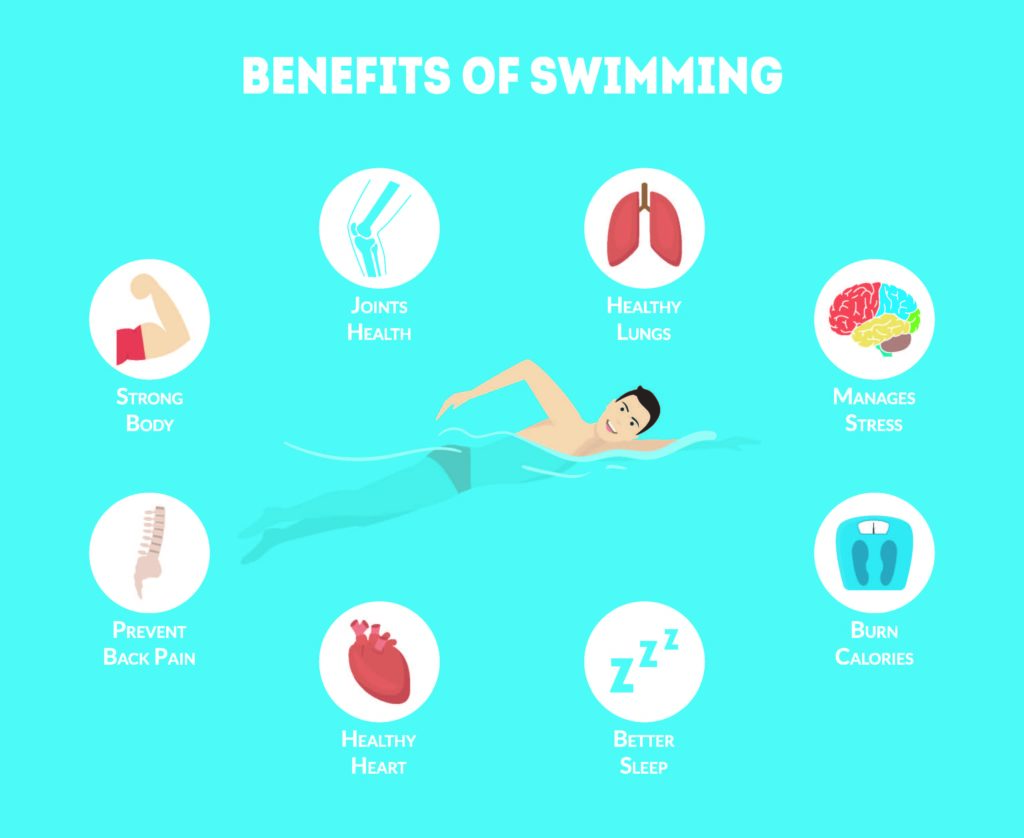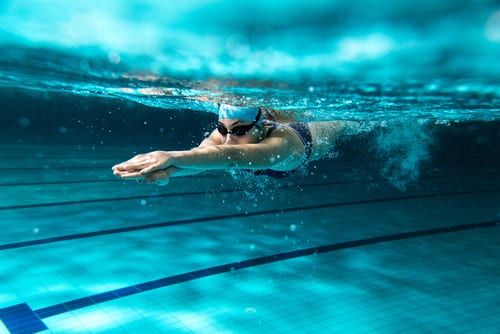While swimming isn’t one of the more convenient workout methods–primarily because it requires a body of water–it happens to be one of the most effective. My opinion? “Swimming is the complete exercise–it’s full body: resistance, endurance, and cardio.”
In addition to the physical benefits demonstrated by the strength of Olympic swimmers, the exercise can also help improve your health in a variety of other ways and is a great workout for anyone regardless of age. It really can be a lifelong activity, particularly beneficial to aging arthritic bodies due to the unloaded benefits of buoyancy, the muscular resistance of the water and cardiovascular fitness.

#1 Swimming is a Full Body Workout
Unlike most cardio workouts, swimming engages nearly every muscle in your body. The majority of cardio modalities like running, elliptical training and stationary bike are lower body dominant, leaving us with underdeveloped upper bodies, particularly the swim-centric shoulder joint—the least stable joint in the body. Swimming distributes work over every major joint and muscle in the body, forcing you to use your legs, arms, core, and back in unison.
# 2 It Serves as Low-Impact Resistance Training
If you are looking for low-impact resistance training, dive right into the water! It’s ten times denser than air. Water requires you to use more force to move through it. Therefore, if you do the same movement on land or on water, you work harder in the water because you are working against resistance. So, instead of adding more weight to ramp up your resistance workout, try a pair of flippers instead. I love using flippers! This adds additional resistance to the lower limbs (especially with a kickboard) and will give you more conditioning and strengthening effects.
#3 It’s a Calorie Burning Machine
Depending on a variety of factors—including stroke, intensity, and body weight—swimming can blast up to 1000 calories per hour! According to a Harvard Medical School study a woman can burn anywhere from 180-266 calories per 30 minutes of recreational swimming, while vigorously swimming laps can blast 300-444 calories.
#4 It’s Easy on the Joints
It’s all about buoyancy. Exercising in water unloads joints and the spine, making it a great option for anyone, but especially for people with joint pain or recovering from an injury, or those who are overweight or obese and may have fatigue or pain when exercising on land.
Since the buoyancy of the water helps to reduce the load on our joints, we can challenge our bodies and improve fitness without worsening pain. Walking in water up to our belly button decreases our effective body weight by about half.
#5 It Can Save Your Life
Learning to float, swim, and tread water comfortably is a potentially life-saving skill. If you can swim, you can not only protect yourself from drowning, but help others who are. Unfortunately, there are racial and socio-economic disparities in swimming ability. According to information from the USA Swimming Foundation, nearly 80% of children in households with incomes less than $50,000 have little to no swimming ability.
I always tell my patients that it’s never too late to learn how to swim. The Red Cross and the YMCA are national organizations with learn-to-swim resources, and many local community centers and gyms have great swimming programs.
#6 It Will Help Improve Cardiovascular Health
Feeling a bit short of breath after a swim? That is because swimming is an amazing form of cardio, as your heart and lungs have to keep pumping oxygenated blood throughout your body in order to keep you moving through the pool. One study conducted by the American Heart Association found that swimming 30 minutes per day may reduce a woman’s chances of developing coronary heart disease by 30%.
However, breathing does not come easy for some when swimming. It requires a rhythm of under water exhales, and surface inhales, coordinated with your stroke and speed. This is why swimmers often demonstrate some of the best breath control in all sports. For decades, swimmers have known about the mechanics of breathing with movement, frequency and CO2 tolerance.
#7 It Will Help You De-stress
While any form of exercise is a great mental health booster, being at one with the water has always had stress relieving benefits for me. In this overly connected, extremely technological world, swimming can be a great way to disconnect, unplug and just immerse yourself in solitude, focused on your breath and movement. It truly is “moving meditation”!
#8 It Can Help Your Body Recover From Other Workouts or Sports
Swimming can be a great in-between workout, even on rest days. “The best athletes are quickly identifying the best “bio-hacks” to improve recovery time between workouts and competition. For many of the reasons stated previously, swimming allows for significant volumes of training with better recovery times. It is an excellent cross-training modality for other sports and can be a lifelong activity that aging athletes can do to offset some of the wear and tear of other sports.
#9 It Can Help With Pain
Swimming is a natural pain reliever. One study found that swimming not only reduced joint pain and stiffness in people suffering from arthritis, but also improved their overall function.
#10 It’s Fun
While hitting the gym may seem like a chore for some, many people find joy in hopping in the pool. (Although packing my swim bag with all my gear is a bit of a chore.) Adding a different element to your workouts is a way to keep things fresh and prevent boredom or plateaus in your fitness regimen. It should help to challenge your mind and body to stay engaged and motivated! Give it a try.

Eduardo Elizondo
MDBoard-Certified Physical Medicine & Rehabilitation
Board-Certified Electrodiagnostic Medicine
Certified Life Care Planner




